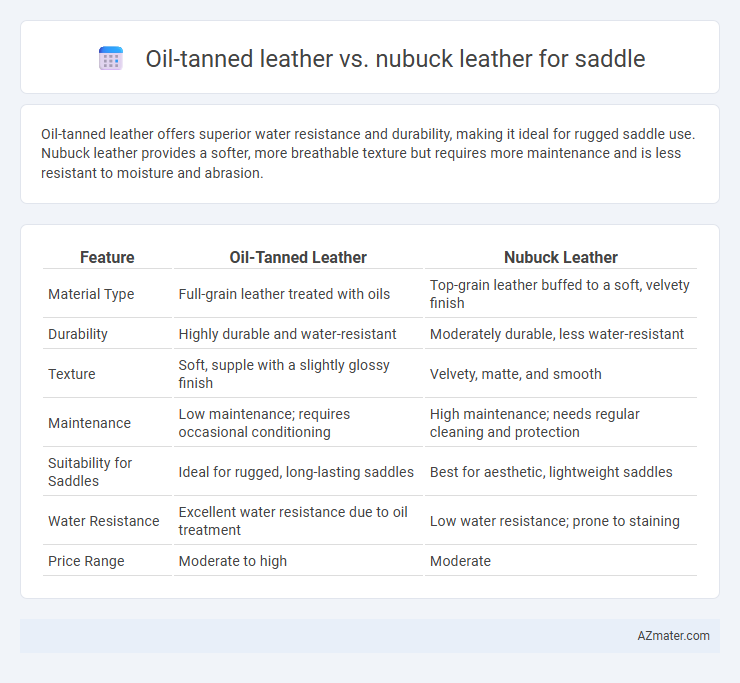Oil-tanned leather offers superior water resistance and durability, making it ideal for rugged saddle use. Nubuck leather provides a softer, more breathable texture but requires more maintenance and is less resistant to moisture and abrasion.
Table of Comparison
| Feature | Oil-Tanned Leather | Nubuck Leather |
|---|---|---|
| Material Type | Full-grain leather treated with oils | Top-grain leather buffed to a soft, velvety finish |
| Durability | Highly durable and water-resistant | Moderately durable, less water-resistant |
| Texture | Soft, supple with a slightly glossy finish | Velvety, matte, and smooth |
| Maintenance | Low maintenance; requires occasional conditioning | High maintenance; needs regular cleaning and protection |
| Suitability for Saddles | Ideal for rugged, long-lasting saddles | Best for aesthetic, lightweight saddles |
| Water Resistance | Excellent water resistance due to oil treatment | Low water resistance; prone to staining |
| Price Range | Moderate to high | Moderate |
Overview of Oil-Tanned Leather and Nubuck Leather
Oil-tanned leather is crafted by infusing oils and waxes into the hide during the tanning process, resulting in a durable, water-resistant surface renowned for its rugged texture and rich patina that develops over time. Nubuck leather is made by sanding the outer grain of the hide to create a soft, velvety nap with a matte finish, prized for its luxurious feel but requiring more care due to its porous nature. Both types offer unique tactile and aesthetic qualities suitable for saddles, with oil-tanned leather excelling in weather resistance and longevity, while nubuck provides a plush, refined appearance.
Key Characteristics of Oil-Tanned Leather
Oil-tanned leather is prized for its durability, water resistance, and rich, glossy finish resulting from the oil infusion process, which enhances its suppleness and longevity. It develops a unique patina over time, making each saddle distinct and appealing to riders seeking both functionality and aesthetic aging. Unlike nubuck, which has a soft, velvety surface prone to staining and moisture sensitivity, oil-tanned leather offers superior protection against environmental elements, ideal for rugged equestrian use.
Key Characteristics of Nubuck Leather
Nubuck leather for saddles features a soft, velvety surface created by sanding the outer grain, which enhances breathability and provides a unique tactile experience. Its porous nature allows for better air circulation, making it comfortable for long rides but requires regular maintenance to prevent staining and water damage. Unlike oil-tanned leather, nubuck offers a matte finish with a slimmer, more flexible profile ideal for riders seeking both durability and aesthetic appeal.
Visual Differences: Texture and Appearance
Oil-tanned leather features a rich, glossy finish with a smooth texture that highlights natural grain patterns, creating a rugged yet polished look ideal for saddles. Nubuck leather displays a soft, velvety surface due to its buffed outer side, offering a matte appearance with slight color variations that emphasize a more rustic and worn-in aesthetic. The shiny, weather-resistant quality of oil-tanned leather contrasts distinctly with nubuck's delicate, suede-like feel, influencing both the saddle's visual appeal and maintenance requirements.
Durability Comparison for Saddle Use
Oil-tanned leather offers superior durability for saddle use due to its dense, water-resistant properties and resistance to cracking under stress. Nubuck leather, while softer and more flexible, is more prone to wear, scuffing, and water damage, reducing its longevity in demanding saddle conditions. For rigorous equestrian activities, oil-tanned leather maintains structural integrity and appearance longer than nubuck.
Comfort and Break-In Periods
Oil-tanned leather offers superior comfort through its natural water resistance and flexibility, softening quickly as oils penetrate the fibers, resulting in a shorter break-in period typically lasting a few weeks. Nubuck leather, known for its velvety texture, provides excellent breathability and a luxurious feel but requires a longer break-in duration, often several months, to achieve maximum softness and conform to the saddle shape. Both leathers improve comfort over time, yet oil-tanned leather excels for riders seeking immediate flexibility and durability.
Water Resistance and Weather Performance
Oil-tanned leather offers superior water resistance due to its oil-infused fibers, making it highly durable against rain and moisture. Nubuck leather, while soft and breathable, lacks the same waterproof qualities and can absorb water quickly, requiring additional treatments for effective weather protection. For saddle use, oil-tanned leather provides better weather performance by maintaining structural integrity and resisting water damage during extended outdoor exposure.
Maintenance and Cleaning Requirements
Oil-tanned leather requires minimal maintenance due to its water-resistant properties and naturally oily finish, which repels dirt and prevents cracking. Nubuck leather, with its soft, velvety surface, demands more frequent cleaning using a specialized nubuck brush and a mild cleaner to maintain its texture and prevent staining. Regular application of a protective spray helps preserve nubuck's appearance, while oil-tanned leather benefits more from occasional re-oiling to retain suppleness.
Price and Long-Term Value
Oil-tanned leather generally commands a higher price due to its enhanced durability and water-resistant properties, making it a popular choice for saddles that require long-term resilience. Nubuck leather, while typically more affordable, offers a softer texture but requires more maintenance and is less resistant to moisture and wear over time. Investing in oil-tanned leather saddles often provides better long-term value through extended lifespan and reduced upkeep costs.
Best Choice: Selecting the Right Leather for Your Saddle
Oil-tanned leather offers exceptional water resistance and durability, making it ideal for rugged saddle use in harsh weather conditions. Nubuck leather provides a softer, velvety texture with excellent breathability and comfort, suited for riders prioritizing aesthetics and light use. Choosing the right leather depends on whether you value long-lasting protection and toughness or a supple feel and refined appearance for your saddle.

Infographic: Oil-tanned leather vs Nubuck leather for Saddle
 azmater.com
azmater.com